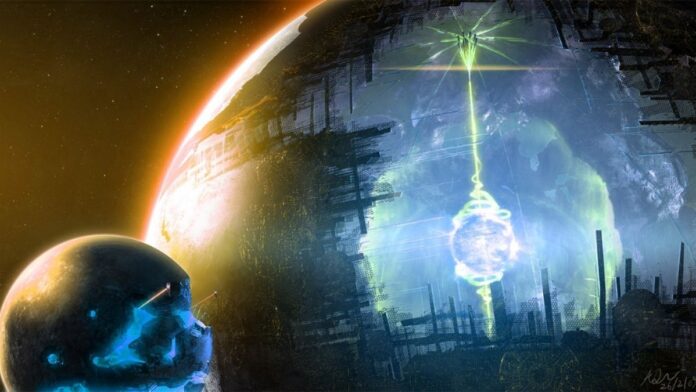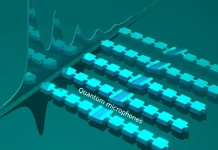
We all know that only a tiny amount of the sun’s energy reaches the Earth, but what if we could harness all of the sun’s energy? If we could do this, we’d use a Dyson sphere, also known as a Dyson shell or megastructure. In 1960 Freeman J. Dyson, a physicist, and astronomer, initially considered this topic a thought experiment.
Dyson imagined a solar-system-sized solar power collection system not as a power source for us earthlings but as a technology that other advanced civilizations in our galaxy would inevitably use. This thought experiment of Dyson was published in a two-page paper in the journal Science titled Search for Artificial Stellar Sources of Infrared Radiation.
According to Dyson, searching for evidence of such structures might lead to the discovery of advanced civilizations elsewhere in this vast galaxy. Thus, in this article, we have tried briefly explaining his concept of a thought experiment known as a Dyson Sphere.
Contents
What is a Dyson Sphere?
The Dyson sphere is a fictitious megastructure, which is like a star and captures a large percentage of its power output from its core. This concept is a thought experiment that attempts to explain that a space civilization, i.e., extraterrestrial life, once it meets its energy requirements, surpasses the requirements that can arise from the planet’s resources alone. Only a fraction of the energy emission of a star reaches the surface of orbiting the earth. Therefore, building structures enclosing a star enables a civilization to gain more energy.
The Dyson-sphere concept is often interpreted as an artificial hollow sphere of matter around a star or an imaginary object. This perception is based on a literal interpretation of Dyson’s original short paper introducing the concept. In response to letters prompted by some papers, Dyson replied, “A solid shell or ring surrounding a star is mechanically impossible. The form of ‘biosphere’ which I envisaged consists of a loose collection or swarm of objects traveling on independent orbits around the star.”
The Dyson sphere is a theoretical mega-engineering enterprise that circles a star with a circumambulation of platforms in tight formation. It is the ultimate answer to building a home and vitality. It gives its creators enough floor space to live and the power to seize each photovoltaic radiation emanating from their central star.
Video Explanation of the Dyson Sphere
Why do we need a Dyson sphere?
Based on the British-American theoretical physicist Freeman Dyson, who first speculated about these athletic buildings in 1960 – days a more advanced alien species attempts after deciding on some of the moons and planets in their native stellar neighborhood Can keep in mind. As their inhabitants grew, they would begin to consume more and more amounts of extraterrestrials.
Increasing the population and trade of this foreign society at a rate of 1% per 12 months, Dyson’s calculation stated that the location and vitality of aliens would evolve rapidly, turning into ample trillion examples in just three thousand years. Their photovoltaic system should include a Jupiter-shaped physique; species engineers can try to determine the best way to move the planet aside and reveal its mass in a spherical shell.
By constructing buildings twice the distance of the Earth-Sun, the fabric may be sufficient to assemble 6 to 10 feet (2 to 3 m) thick orbiting platforms, allowing aliens to remain on their star-facing floor.
Dyson wrote that a shell of this thickness could be comfortably habitable and contain all the equipment needed to harness photovoltaic radiation.
However, after absorbing and exploiting photo voltaic vitality, the construction would eventually need to reorganize the energy. Otherwise, it would build, finally softening the area, keeping Dyson in mind.
For a distant observer, the sunlight of a star wrapped in the Dyson field can become dim and even completely dark – depending on how dense the orbiting platform is – shining infrared. Flammable in wavelengths that the naked eye can not see.
Do Dyson Spheres Exist in the Universe?
Due to its infrared radiation, Dyson fields are thought of as a kind of technical signature – a sign of exercise that distant astronomers are using to reduce the existence of intelligent creatures within the universe; according to NASA’s report, A handful of Earth-based researchers have scanned night-time infrared maps in hopes of recognizing the Dyson regions, although so far, none have seen anything unusual.
Tabetha S. Boyajian
In 2015, astronomer Tabetha S. Boyajian at Yale University reported the mysterious decrease of sunlight from a star as KIC 8462852, an irregular flicker of nothing like the researchers had ever seen. Individual students resulted from bizarre mild dips from a partially constructed Dyson area, and the concept inspired a media sensation.
The campaign to search for various indicators of technical practice from the unit, commonly known as Tabby’s Star in honor of Boyajian, has been vacated. Most researchers now believe that the light pattern of the item has no Alien is some form of rationalization.
The Dyson fields have been a staple of science fiction media for many years. On the way to 1937, author Olaf Stapledon’s novel “Star Maker” (Mathewane Publishing, 1937) described how methods in a single clear galaxy are “surrounded by a haze of Sunshine Trap, which uses creative photo voltaic vitality. Concentrates, so that the entire universe was dimmed, “Dyson acknowledged as an influence on his idea.
In his novel “Ringworld” (Ballantine Books, 1970), author Larry Niven described a ring-shaped synthetic construction that featured an episode of “Star Trek: The Subrandet Technology” in 1992, surrounded by a hard shell. Hua was a star.
Human creativity can still be seen whether such imaginary buildings exist outside. In its estimates, Dyson was not suggesting that all technological societies implement this external undertaking. But, to some extent, some may be needed, he argued, and because of this fact, it would be worthwhile for human astronomers to seek out these great examples of clever minds.
Forms of Dyson Spheres
There are many forms of Dyson Spheres or types of Dyson Spheres, Like “Dyson swarm,” “Dyson bubble,” “Dyson shell,” “Dyson net,” “Bubbleworld,” and “Stellar engine.”
Dyson Swarm

A Dyson Swarm or Dyson Shell, is also a theoretical megastructure concept proposed by the physicist and mathematician, Freeman Dyson, just like Dyson Sphere. The idea behind a Dyson Swarm is to harness the energy of a star, typically our Sun, by surrounding it with a vast array of solar-collecting structures or satellites. The primary purpose of such a megastructure would be to capture and utilize a significant portion of the star’s energy output.
Here are some key points about Dyson Swarms:
- Energy Harvesting: The primary goal of a Dyson Swarm is to capture and utilize the energy emitted by a star. This energy could be used for a wide range of purposes, including powering advanced civilizations, supporting interstellar travel, or even terraforming planets.
- Solar Collectors: Dyson proposed the use of solar-collecting satellites, often referred to as Dyson Spheres, Dyson Shells, or Dyson Swarms, to capture solar energy. These satellites would be positioned in a spherical or orbital formation around the star.
- Types of Dyson Swarms: There are different variations of Dyson Swarms, including partial Dyson Swarms (where only a fraction of the star’s energy is captured) and complete Dyson Swarms (where the star is completely enclosed). Partial Dyson Swarms may be more feasible and less resource-intensive to construct.
- Technical Challenges: Building a Dyson Swarm is a monumental engineering challenge, requiring advanced technology and vast amounts of resources. It would involve launching and positioning an enormous number of satellites in stable orbits around the star, which presents numerous logistical and technical hurdles.
- Potential Benefits: A Dyson Swarm would provide an almost limitless and sustainable energy source for advanced civilizations. It could also serve as a way to detect the presence of extraterrestrial civilizations, as the energy output of a star would be significantly altered when enclosed in such a structure.
- Speculative Nature: While the concept of a Dyson Swarm is intriguing and has captured the imagination of scientists and science fiction writers, it remains purely theoretical at this point. The technical challenges and resources required are beyond our current capabilities.
Difference Between Dyson Swarm and Dyson Sphere
A Dyson Swarm and a Dyson Sphere are related concepts, both proposed by physicist and mathematician Freeman Dyson, but they represent different approaches to harnessing the energy of a star, such as our Sun. Here are the key differences between the two:
The difference between a Dyson Swarm and a Dyson Sphere lies in their structure and configuration. A Dyson Sphere is a solid, enclosed megastructure that surrounds a star, while a Dyson Swarm is a collection of distributed solar collectors in various orbits around the star. Dyson Swarms are generally seen as more practical and adaptable, while Dyson Spheres are considered a more ambitious and resource-intensive concept. Both ideas remain theoretical and have not been realized with current technology.
Structure and Configuration
- Dyson Sphere: A Dyson Sphere is a theoretical megastructure that completely encircles a star, capturing all or nearly all of its energy output. It would be a solid shell or structure surrounding the star, essentially turning the star into a central power source for an advanced civilization. The idea is to create a hollow, closed structure with the star at its center.
- Dyson Swarm: A Dyson Swarm, on the other hand, is a collection of many individual solar-collecting satellites or structures positioned in various orbits around the star. It doesn’t completely enclose the star but rather forms a network or cloud of solar collectors, often arranged in a spherical or orbital pattern. It is a more distributed approach to capturing starlight.
Feasibility and Resource Requirements
- Dyson Sphere: Building a complete Dyson Sphere is an immensely challenging engineering feat due to the enormous size and materials required. It would require vast resources, likely beyond our current technological capabilities. It’s often seen as a more ambitious and resource-intensive concept.
- Dyson Swarm: Dyson Swarms are considered a more practical and feasible approach because they don’t require the construction of a solid shell around the star. Instead, they involve launching and positioning a large number of individual satellites or collectors in space. While still an enormous undertaking, it may be more achievable than a complete Dyson Sphere.
Variability and Adaptability
- Dyson Sphere: Once constructed, a Dyson Sphere is a relatively fixed structure. It captures a consistent amount of energy from the star, and any adjustments or repairs would be extremely challenging.
- Dyson Swarm: Dyson Swarms offer more flexibility and adaptability. Satellites within the swarm can be repositioned, replaced, or expanded as needed. This allows for better control over the amount of energy captured and the ability to respond to changing energy demands.
Conclusion
In summary, a Dyson Swarm and Dyson Sphere are hypothetical megastructures designed to capture and utilize the energy of a star. While it remains a fascinating idea, it is currently a speculative concept and not something that has been realized or demonstrated in practice.
FACT CHECK: We strive for accuracy and fairness. But if you see something that doesn’t look right, please Contact us.
DISCLOSURE: This Article may contain affiliate links and Sponsored ads, to know more please read our Privacy Policy.
Stay Updated: Follow our WhatsApp Channel and Telegram Channel.











